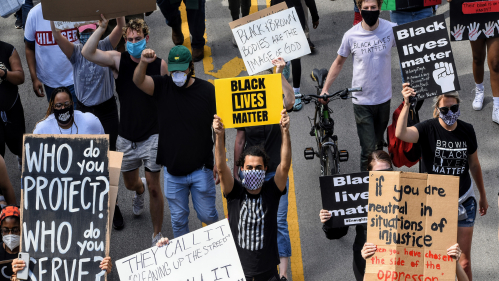Police Reform Following George Floyd Murder: One Year Later

One year ago, the murder of George Floyd by police in Minneapolis sparked a national outcry over racial justice, including calls to reform policing. But how far have we come over the last year? Rutgers sociologist Paul Hirschfield discusses U.S. police practices, the changes made and the changes still needed since Floyd’s killing.
How has policing changed since May 25, 2020?
Since George Floyd was murdered by police so much has changed in American policing and so much has not. Before the murder, the media and official discourse centered on the changes that police departments need to implement to become more restrained, transparent and accountable. But Floyd's murder and the ensuing massive public outcry seemed to immediately trigger widespread recognition that the system that led Derek Chauvin and his accomplices to completely disregard Floyd's health and humanity – and the risk of meaningful accountability – was incapable of fixing itself. Instead, the public demanded that external actors impose reforms on the police and/or invest in alternative approaches to community safety that do not involve armed police. Calls for the democratic governance of policing created unprecedented political opportunities for various city councils, mayors, state legislatures and state attorneys general, including in New Jersey, to enact bold reforms that previously would have gone nowhere. Reforms included making police disciplinary records public, restricting how and when police can use deadly force, limiting qualified immunity and re-allocating some "police work" to unarmed traffic agents and social workers. Even the U.S. House of Representatives passed the most sweeping federal police bill I have ever seen with the George Floyd Justice in Policing Act.
How widespread have the post-Floyd reforms been?
Although the reforms passed in the last year are remarkable, the appetite for substantive police reform varies greatly across America's fragmented social landscape. Calls to "defund the police" and jarring news accounts of unrest, looting, and rising violent crime were easily (and sometimes cynically) weaponized by opponents of police reform. Racialized fears of crime have continually thwarted police reforms, but structural impediments are at least as important. Most police and sheriff's departments are small and lack the resources and the political will needed to implement substantive reforms. Few state governments are providing meaningful assistance and mandates. Just how little has changed for most police departments was poignantly demonstrated on April 21, 2021, the day after Derek Chauvin was convicted of murder. On that day, three sheriff's deputies who attempted to serve an arrest warrant on the unarmed Andrew Brown Jr. in Elizabeth City, N.C., fired 13 shots at him as he fled in his car, fatally shooting him in the back of the head. The sheriff's department refused to release key details about the shooting. After the district attorney exonerated the officers, only carefully selected clips of body camera have been released. A judge is keeping them under seal. Andrew Brown Jr. is not an isolated incident.
What can we say about the last year?
The past year has been a study in contrasts. Some politicians have passed unprecedented, substantive police reforms, including humane policing alternatives. And they did so to be responsive and accountable to the people. Other politicians, citing the same motive, have permitted police officers to get away with a seeming cold-blooded murder vividly captured on camera. Meanwhile, the consequences of past inactions and injustices continue to smolder.


